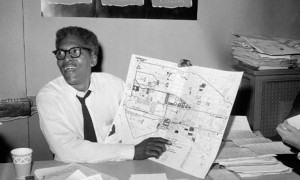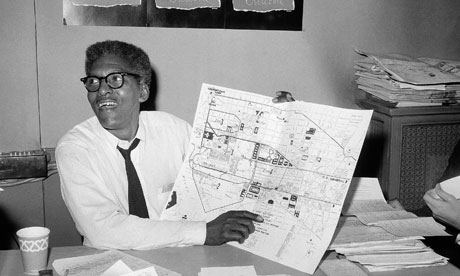
By Rachel A. Adler
Online Learning Tips, Guest Contributor
Do you know who Bayard Rustin is? Have you ever heard of him? Bayard Rustin, one of the country’s most influential, and most overlooked, civil rights strategists. He was a Quaker, African American, and gay. When President Obama went to the Henry Ford Museum near Detroit on April 18, 2012, he got to visit one of the shrines of the civil rights movement that was a factor in the future election of the nation’s first African-American president. “I actually had the chance to sit in Rosa Parks’ bus,” Obama said. “I just sat there for a moment and pondered the courage and tenacity that is part of our very recent history, but is also a part of that long line of folks — sometimes nameless, oftentimes didn’t make the history books — but who constantly insisted on their dignity, their stake in the American Dream.” Parks’ refusal to move to the back of that bus on Dec. 1, 1955, in Montgomery, Ala., led to her arrest, which led to a bus boycott by African Americans, which led to the creation of the Montgomery Improvement Association, which led to the elevation of a young minister named Martin Luther King Jr.
Said Obama at another stop: “It takes ordinary citizens to bring about change, who are committed to keep fighting and keep pushing, and keep inching this country closer to our highest ideals.”
Only recently President Obama paid tribute to the great Bayard Rustin. On November 20, 2013, fifty years after Bayard Rustin the chief architect of the 1963 ‘March on Washington for Jobs & Freedom” was posthumously awarded the Presidential Medal of Freedom Recipients. But is that enough?
Now many of you are wondering who is this man I speak of? Why am I correlating Rosa Park’s ‘Freedom Rides’ to Bayard Rustin? I believe that is important to understand how the multiple freedom rides and bus sit in prior led to Rosa Parks historic moment and that is where Bayard Rustin comes in.
Prior to Ms. Parks there had been many ‘freedom rides’. The Freedom Riders were inspired by the 1947 Journey of Reconciliation, led by civil rights activists Bayard Rustin and George Houser. Rustin and Houser organized the Journey of Reconciliation in 1947. This was the first of the Freedom Rides to test the ruling of the Supreme Court of the United States that banned racial discrimination in interstate travel (Irene Morgan v. Commonwealth of Virginia). Rustin and CORE (Congress of Racial Equality) executive secretary George Houser recruited a team of fourteen men, divided equally by race, to ride in pairs through Virginia, North Carolina, Tennessee, and Kentucky.
The NAACP ( National Association for the Advancement of Colored People) opposed CORE’s Gandhian (It is a body of ideas and principles that describes the inspiration, vision and the life work of Mahatma Gandhi. It is particularly associated with his contributions to the idea of nonviolent resistance, sometimes also called civil resistance) tactics as too meek. Participants in the Journey of Reconciliation were arrested several times. Arrested with Jewish activist Igal Roodenko, Rustin served twenty-two days on a chain gang in North Carolina for violating Jim Crow laws regarding segregated seating on public transportation.
In one of his own “Rosa Parks moments” he was quoted saying: “I cannot move.” The police came, and they started dragging Bayard out of his seat. And he pointed to a little white child across the aisle saying, “If I move, this child will not know that injustice is taking place here.”
Bayard Rustin is one of 20th century America’s boldest social activists, most masterful strategists of peaceful protest, and brilliant organizers. Thanks to Rustin, civil disobedience became a powerful catalyst for political change in this country. In my opinion, without Rustin as his steadfast mentor, adviser and confidant, Dr. Martin Luther King, Jr. would not have understood the impact of direct action, which defined his civil rights leadership. He is the man who organized one of the greatest and most significant marches of American History. That’s right he organized the March on Washington in 1963, an event attended by more than 200,000 people. Besides that huge accomplishment Bayard was always a forefront is making sure justice & liberties where served to all.
While Bayard Rustin had been peacefully trying to change the social injustice of America since the early 1940’s, his open sexuality caused many close to him to hide their work and friendships from the public. Although King’s speech ultimately left the most indelible mark on America’s memory of the event, it was a photo of the march’s two organizers, A. Philip Randolph and Bayard Rustin, that was chosen as the photographic icon of the historic event (Life Magazine). Randolph, Dr. Martin Luther King and others fearing his (Bayard Rustin) sexuality would discredit the event, appointed Randolph as the director, and Randolph appointed Rustin deputy organizer. Bayard Rustin historian, John D’Emilio, author of Lost Prophet: The Life and Times of Bayard Rustin, explained that Rustin only had eight weeks to organize the March. Talk about time management skills. The following eight weeks, writes D’Emilio, “were the busiest in Rustin’s life. He had to build an organization out of nothing. He had to assemble a staff and shape them into a team able to perform under intense pressure. He had to craft a coalition that would hang together despite organizational competition, personal animosities and often antagonistic politics. He had to maneuver through the mine field of an opposition that ranged from liberals who were counseling moderation to segregationists out to sabotage the event. And he had to do all of this while staying enough out of the public eye so that the liabilities he carried would not undermine his work.” While Bayard was ever the big dreamer, he also had the ability to reach out and see the bigger picture. He once explained: “What you have to understand is that the march will succeed if it gets 100,000 people — or 150,000 or 200,000 or more — to show up in Washington. It will be the biggest rally in history. It will show the Black community united as never before — united also with whites from labor and the churches, from all over the country.” 250,000 people would ultimately be there.
Now many history books overlooked Bayard Rustin compared with other more well known civil rights leaders, due in part because of societal views regarding his sexual orientation at the time, but there’s been renewed recognition of his overall contributions in recent years. Looking back at his career, Mr. Rustin, a Quaker, once wrote: ‘The principal factors which influenced my life are 1) nonviolent tactics; 2) constitutional means; 3) democratic procedures; 4) respect for human personality; 5) a belief that all people are one.’ March 17, 2012 marked the 100th birthday of Bayard Rustin. While King’s birthday is now a national holiday, Rustin by and large languishes in historical limbo.
Americans should know about and remember Bayard Rustin. His name should be synonymous with organization, strategic planning and Human Rights Activism especially in the Civil Rights movement. When I look back at the history books or think about what I learned in elementary, high schol, and college, I’m compelled to ask, “Where is Bayard Rustin?”
About the Author
Rachel is a native NYer who has ventured down south to be part of the incredible APUS Team. She is a Tweet-aholic as well as digital native. When she is not experimenting in the kitchen, listening to records, or reading whatever she can get her hands on she likes to volunteer her time to various causes and community events to try and make the world a little better then how she received it. She’s also a political junkie and pop culture savant.

Comments are closed.